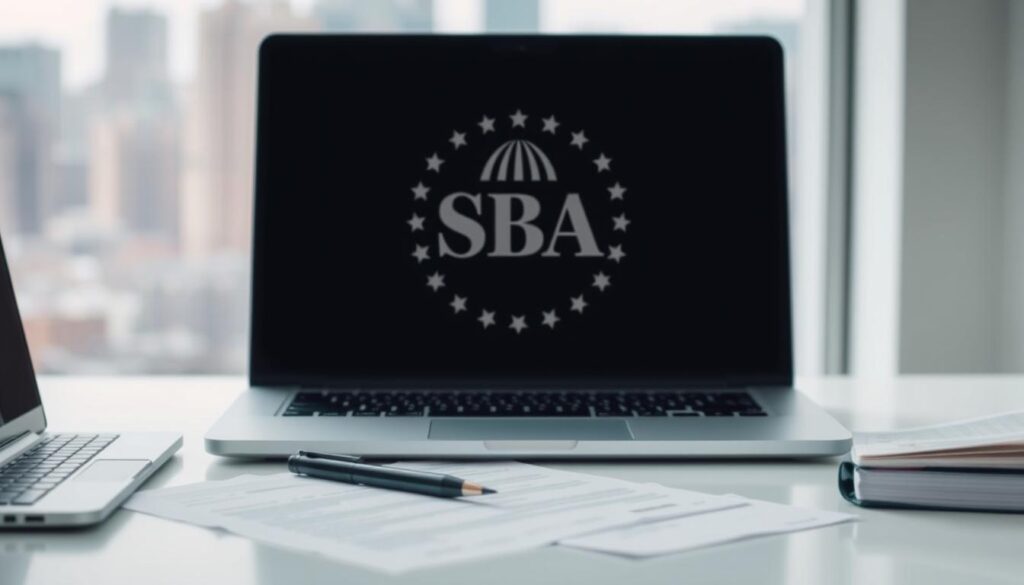What if you could unlock your small business full potential with the right financing? As a small business owner, getting access to capital is key for growth. There are many funding options out there, making it hard to choose the right one. The secret to success is knowing your options and picking the best fit for your business.
Small business funding is vital for growing, hiring, and boosting sales.

Small businesses are the heart of the US economy, and getting capital is essential for them to thrive. Finding the right financing can be tough, especially for new entrepreneurs. This article aims to guide small business owners in making smart financing choices. We’ll cover small business funding and other financing options.
Key Takeaways
- Small business funding is crucial for business growth and success
- Understanding business financing options is essential for making informed decisions
- Various financing options are available, including traditional bank loans and alternative funding sources
- Choosing the right financing option depends on your business needs and goals
- Small business funding can help you expand your operations, hire more employees, and increase revenue
- Business financing options include small business funding and other alternative sources
Understanding Small Business Funding Essentials
Small businesses often need outside money to grow and succeed. A survey by the National Small Business Association found that 64% use loans or credit cards. This shows how crucial it is to know about small business loans and microloans.
Small businesses have many funding choices. These include bank loans, lines of credit, and other options. It’s key to pick the best funding for the business’s needs.
Why Businesses Need External Funding
Outside funding helps small businesses buy new equipment, hire staff, and grow. It also helps with cash flow and financial hurdles.
Types of Funding Available
Some common funding types for small businesses are:
- Loans: Traditional bank loans, small business loans, and microloans
- Lines of credit: Revolving credit lines for borrowing and repaying as needed
- Alternative funding sources: Crowdfunding, peer-to-peer lending, and invoice financing
Matching Funding to Business Needs
To choose the right funding, small businesses should think about their needs and goals. For example, a loan might be best for buying equipment. But a line of credit could be better for managing cash flow. By picking the right funding, businesses can make smart choices and succeed in the long run.
Traditional Bank Loans: What You Need to Know
Traditional bank loans are a top choice for small businesses in the U.S. The Federal Reserve says they’re the most common funding source. To get a bank loan, businesses need a good credit score, a solid plan, and a clear use for the funds.
The Small Business Administration (SBA) helps by guaranteeing loans. This makes it easier for small businesses to get sba loans and other financing. Traditional bank loans offer benefits like:
- Lower interest rates than other options
- Longer repayment terms for easier payment
- A chance to build credit and work with a bank
But, traditional bank loans have downsides too. They have strict rules and a long application process. Businesses should think carefully about these loans and look at other business financing options.
The SBA has different loan programs, like the 7(a) loan. It helps small businesses buy equipment, grow, or pay off debt. Knowing the pros and cons of traditional and sba loans helps business owners make better funding choices.

SBA Loans: Government-Backed Financing Solutions
The Small Business Administration (SBA) offers sba loans and business lines of credit to support small businesses. These loans help businesses buy real estate, equipment, or inventory.
Some key SBA loan programs include:
- 7(a) loan program: helps small businesses buy real estate, equipment, or inventory
- 504 loan program: supports small businesses in buying real estate or equipment
- Microloan program: assists small businesses in buying inventory or supplies
To get an SBA loan, businesses need a good credit score and a solid business plan. They must submit financial statements, tax returns, and other documents to the lender.

Understanding SBA loans and their requirements helps small business owners decide if they’re a good fit. Business lines of credit are also useful, offering access to funds as needed.
| Loan Program | Financing Amount | Interest Rate |
|---|---|---|
| 7(a) loan program | Up to $5 million | 5-10% |
| 504 loan program | Up to $5.5 million | 5-10% |
| Microloan program | Up to $50,000 | 5-10% |
Business Lines of Credit: Flexible Funding Options
Managing cash flow is key for small businesses. A survey by the National Federation of Independent Business shows 64% use lines of credit for this. Business lines of credit let businesses borrow and repay as needed. This is great for those with changing income or expenses.
Considering alternative funding options, business lines of credit stand out. They offer a revolving credit limit for unexpected costs or new chances. But, knowing the pros and cons is crucial. Some advantages include:
- Flexibility in borrowing and repayment
- Ability to cover unexpected expenses
- Opportunity to take advantage of new business opportunities
However, there are downsides like interest rates and fees. To use them wisely, businesses need a solid repayment plan. This helps avoid debt. By weighing the pros and cons, small business owners can pick the best alternative funding options for their needs.

Business lines of credit can be a big help for small businesses. They offer the needed flexibility and funding for success. By understanding the benefits and drawbacks and choosing wisely, businesses can thrive in the long run.
| Funding Option | Benefits | Drawbacks |
|---|---|---|
| Business Lines of Credit | Flexibility, ability to cover unexpected expenses | Interest rates, fees |
| Alternative Funding Options | Opportunity to take advantage of new business opportunities | Higher interest rates, stricter repayment terms |
Exploring Alternative Small Business Funding Sources
Small businesses have many funding options besides traditional bank loans. A report by CB Insights shows that alternative funding options like crowdfunding and peer-to-peer lending are gaining popularity. These choices help businesses get the funds they need to grow and expand.
Some well-known alternative funding options include:
- Crowdfunding platforms, which allow businesses to raise funds from a large number of people
- Peer-to-peer lending, which connects businesses with investors who provide loans
- Invoice financing, which allows businesses to receive advances on outstanding invoices
These startup funding options are great for businesses that can’t get bank loans. By looking into these alternatives, businesses can find the funding they need to thrive.
Understanding the different alternative funding options helps small business owners make smart financing choices. It lets them avoid relying only on traditional bank loans. This way, they can find the best startup funding for their business.
| Funding Option | Description |
|---|---|
| Crowdfunding | Raising funds from a large number of people |
| Peer-to-Peer Lending | Connecting businesses with investors who provide loans |
| Invoice Financing | Receiving advances on outstanding invoices |
Microloans: Small-Scale Financing Solutions
Microloans are a favorite choice for small businesses. In 2020, over 50,000 microloans were approved by the SBA. They give entrepreneurs the funds they need to start or expand their businesses.
Benefits of Microloans
Microloans have many perks. They offer small loan amounts and are easier to qualify for. This is great for small businesses that can’t get traditional loans. Plus, they have shorter repayment terms, helping businesses avoid long-term debt.
Application Requirements
To get a microloan, businesses must have a solid business plan. They also need to show they can pay back the loan and meet the lender’s rules. Some lenders might ask for collateral or a personal guarantee. It’s key for business owners to know what’s needed to apply for a microloan.

Looking into microloans can help entrepreneurs get the money they need. With the right lender and a good business plan, small businesses can really take off.
Startup-Specific Funding Opportunities
For startups, getting funding is key to making their business idea real. Luckily, there are many startup funding choices out there. These include venture capital, angel investors, and crowdfunding. A report by Seedrs shows these options can help startups grow and thrive.
Some main small business loans and funding choices for startups are:
- Venture capital: gives funding in exchange for a share of the business
- Angel investors: gives funding for a share of the business, often with a personal touch
- Crowdfunding: lets businesses get money from lots of people, usually online
To get startup funding, having a strong business plan is crucial. Showing how your business can grow will attract investors. With the right funding, startups can become successful, creating jobs and driving new ideas.
In summary, small business loans and funding choices are out there for startups. By knowing these options, entrepreneurs can make smart financing choices and avoid common mistakes.
| Funding Option | Description |
|---|---|
| Venture Capital | Provides funding in exchange for equity in the business |
| Angel Investors | Provides funding in exchange for equity in the business, often with a more personal approach |
| Crowdfunding | Allows businesses to raise funds from a large number of people, typically through an online platform |
Preparing Your Business for Funding Success
To boost their chances of getting business financing, small business owners need to get ready for the funding process. This means several important steps, like preparing documents, improving credit scores, and creating a business plan. A report by the SBA shows that a good business plan is key. It shows the company’s goals, target market, and financial plans.
A strong business plan should have:
- Financial forecasts, like income statements and cash flow predictions
- Market analysis, covering the target audience and competitors
- A detailed description of what the business offers
With a solid business plan, owners can show they’re serious and increase their funding chances. Also, improving credit scores and getting ready documents, like financial statements and tax returns, makes the application smoother.
By preparing well, small business owners can set themselves up for success. This way, they can get the business financing they need to grow and succeed.
Conclusion: Choosing the Right Funding Path for Your Business
Small businesses have many funding options to grow and succeed. You can choose from bank loans, SBA financing, or alternative sources. The most important thing is to pick the option that fits your business goals.
When picking a funding option, think about interest rates, fees, and repayment terms. This helps you avoid extra costs and ensures the funding supports your business’s future. By understanding your options and making a smart choice, you can get the resources to make your business bigger.
Discover the Best Cryptocurrency to Invest in for 2025
FAQ
What are the different types of small business funding options available?
Small businesses can choose from many funding options. These include bank loans, SBA loans, and business lines of credit. There’s also crowdfunding, peer-to-peer lending, invoice financing, and microloans. Each option has its own pros and cons, depending on the business’s needs and goals.
What are the benefits and drawbacks of traditional bank loans?
Traditional bank loans are a common choice for small businesses. They offer larger loan amounts and longer repayment terms. But, they also have strict requirements like good credit and collateral.
What are SBA loans and how do they work?
SBA loans are backed by the government, helping small businesses get capital. The SBA has several programs, like the 7(a) and 504 loan programs. These loans often have easier eligibility and lower interest rates than bank loans.
What is a business line of credit and how can it benefit my small business?
A business line of credit lets small businesses borrow as needed. It helps manage cash flow and access funds quickly. But, it may have higher interest rates and fees than traditional loans.
What are the advantages and disadvantages of alternative funding options, such as crowdfunding and peer-to-peer lending?
Options like crowdfunding and peer-to-peer lending offer capital outside of banks. They’re quick and often have less strict requirements. But, they might have higher interest rates and fees, and need a strong marketing effort.
What are microloans and how can they benefit my small business?
Microloans offer small amounts of money, usually up to $50,000. They have flexible requirements and lower interest rates. But, they might not be enough for businesses needing more money.
What steps should I take to prepare my small business for funding success?
To get funding, focus on these steps: 1) Organize your financial documents and business plan. 2) Improve your credit score. 3) Make sure your business plan meets the funding source’s needs.











